MissPrissy
Chillin' with the herd
- Joined
- Jul 9, 2008
- Messages
- 40
- Reaction score
- 0
- Points
- 27
This is for those who would like to make cultured buttermilk. CULTURED buttermilk is also an excellent starter for making cheese, too.
There are two kinds of buttermilk. One is cultured buttermilk, the thick creamy tart milk we find most often in the grocery stores. The other is 'old fashioned buttermilk' or the whey (watery yellowish liquid) that remains from milk when making cheese or churning butter. Two completely different things but both very good and useful in your kitchen (and for your chickens!).
For cultured buttermilk you can buy a dry bacteria culture and start from scratch or you can use a good buttermilk that you like that is labled 'cultured buttermilk' (from the store) to make your own.
Back at Thanksgiving when my mother was here we made so many pans of biscuits (almost twice a day everyday for a week!) that I ran out of buttermilk and had to go to the store and buy a quart.
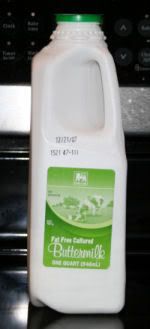
What was left I used to make more buttermilk.
Take a clean jar with a tight fitting lid and fill it with about 8 oz of good cultured buttermilk (check the date and make sure its good because the bacteria can die and then it won't be useful in making more).
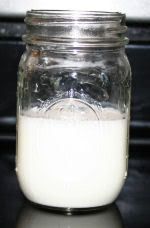
Top off the jar with fresh whole milk. Skim and 2% milk will work just fine but those don't make as creamy and rich of a buttermilk. My goats milk makes a nice thick buttermilk.
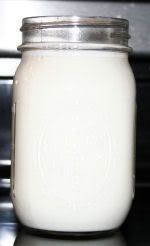
I use the jars of milk that have sat in my fridge and usually choose the one with the thickest amount of cream that has come to the top. For those of you who don't have access to fresh milk I am so sorry because the whole fatty cream filled milk is like cheating because you can't get the same incredible richness from commercial milk. You can still make an excellent product from store bought milk but the fresh from the tap is even more awesome.
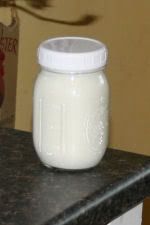
Put the lid on the jar tightly and place it in a warm place for at least 24 hours. I keep mine on the corner of counter closest to my wood stove. It is warm there and the bacteria that make the buttermilk love it there.
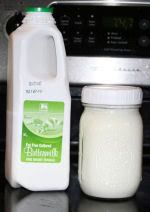
After 24 hours the milk in the jar is the same as the milk that came out of the container - only I made it at home and didn't have to go out to the store and spend more money for it.
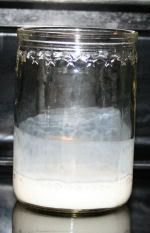
The buttermilk should be thick and creamy. It should have a tart taste, not bitter. When you pour it the milk should coat the inside of the glass.
If your buttermilk isn't thickening after 24 hours let it sit for and extra 12 hours. If at the end of 36 hours it isn't thick this mean the culture had died priot to your using it to make more buttermilk. Start over with a fresh container of buttermilk.
If at the end of 36 hours if it is thick this one might be a bit too tart for drinking but perfectly fine for baking and other cooking needs.
Refrigerate your buttermilk and it should last several weeks - unless you use it all up quickly. In that case you need to make more!
If you don't want to culture buttermilk from a commercially made buttermilk you can buy the culture here to make it. You can also save the whey from making your cheese and use that to culture more buttermilk. Just remember the whey won't be thick and creamy, it will be thin, watery and more acidic and sour than the one we cultured here that is tart.
There are two kinds of buttermilk. One is cultured buttermilk, the thick creamy tart milk we find most often in the grocery stores. The other is 'old fashioned buttermilk' or the whey (watery yellowish liquid) that remains from milk when making cheese or churning butter. Two completely different things but both very good and useful in your kitchen (and for your chickens!).
For cultured buttermilk you can buy a dry bacteria culture and start from scratch or you can use a good buttermilk that you like that is labled 'cultured buttermilk' (from the store) to make your own.
Back at Thanksgiving when my mother was here we made so many pans of biscuits (almost twice a day everyday for a week!) that I ran out of buttermilk and had to go to the store and buy a quart.

What was left I used to make more buttermilk.
Take a clean jar with a tight fitting lid and fill it with about 8 oz of good cultured buttermilk (check the date and make sure its good because the bacteria can die and then it won't be useful in making more).

Top off the jar with fresh whole milk. Skim and 2% milk will work just fine but those don't make as creamy and rich of a buttermilk. My goats milk makes a nice thick buttermilk.

I use the jars of milk that have sat in my fridge and usually choose the one with the thickest amount of cream that has come to the top. For those of you who don't have access to fresh milk I am so sorry because the whole fatty cream filled milk is like cheating because you can't get the same incredible richness from commercial milk. You can still make an excellent product from store bought milk but the fresh from the tap is even more awesome.

Put the lid on the jar tightly and place it in a warm place for at least 24 hours. I keep mine on the corner of counter closest to my wood stove. It is warm there and the bacteria that make the buttermilk love it there.

After 24 hours the milk in the jar is the same as the milk that came out of the container - only I made it at home and didn't have to go out to the store and spend more money for it.

The buttermilk should be thick and creamy. It should have a tart taste, not bitter. When you pour it the milk should coat the inside of the glass.
If your buttermilk isn't thickening after 24 hours let it sit for and extra 12 hours. If at the end of 36 hours it isn't thick this mean the culture had died priot to your using it to make more buttermilk. Start over with a fresh container of buttermilk.
If at the end of 36 hours if it is thick this one might be a bit too tart for drinking but perfectly fine for baking and other cooking needs.
Refrigerate your buttermilk and it should last several weeks - unless you use it all up quickly. In that case you need to make more!
If you don't want to culture buttermilk from a commercially made buttermilk you can buy the culture here to make it. You can also save the whey from making your cheese and use that to culture more buttermilk. Just remember the whey won't be thick and creamy, it will be thin, watery and more acidic and sour than the one we cultured here that is tart.

